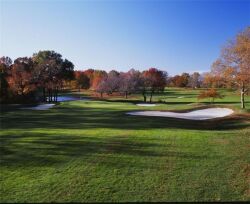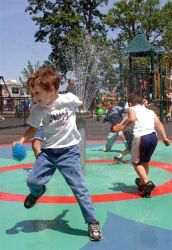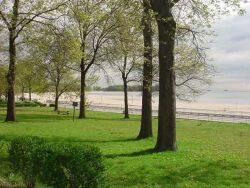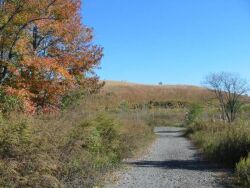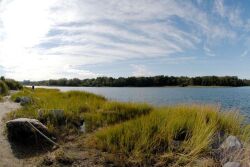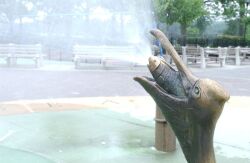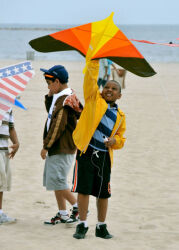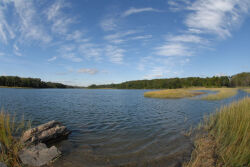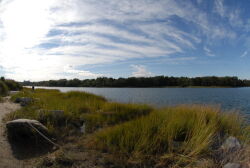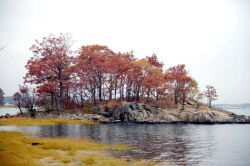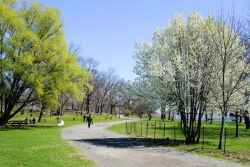Pelham Bay Park
Orchard Beach
Orchard Beach is one of Pelham Bay Park’s most distinctive features. Even though the beach itself is relatively new, visitors dating back to the early Native American tribes walked the area’s beaches and nearby islands for hundreds of years. While the beach’s name recalls the orchards that once graced private estates in the area, the site is in fact the product of a large public works project incorporating landfill and barge-loads of sand. The beach was one of Parks Commissioner Robert Moses’s (1888–1981) most beloved projects.
By the turn of the 20th century, Hunter Island, at the north end of the current site, was a popular campsite for summer visitors. The Bronx Parks Department issued permits to use the island, but the practice soon ceased after vandalism became a problem at the unsupervised site. In 1903, Parks opened a supervised facility with bathhouses, picnic tables, and cooking facilities on Rodman’s Neck, which includes the south end of the site. By 1907, the Bronx Parks Department had cleared land near the beach for campsites and began issuing permits again. Camping increased steadily in subsequent years, and by 1917, seasonal attendance had risen to half a million users.
By the time Moses was named Parks Commissioner in 1934, the campsite had become a well-established colony, complete with a city-like infrastructure. Campers enjoyed conveniences such as street cleaning, mail and fire service, ice delivery, and garbage hauling. Tents that Parks built in the early part of the century gave way to more stable structures with electricity, running water, and telephone service. After a lawsuit was filed in 1927, the city moved to officially endorse this arrangement. Moses remained wary of the encampment's elite appearance, however, and devised a plan to create a facility that the entire city could use. In February 1934, he gave the campers a year to vacate the site.
Moses’s ambitious $8 million plan to renovate the area called for a parking lot, bathhouse, and, most impressive, 115 new acres of land using over 3 million cubic yards of sanitation landfill to join Rodman’s Neck and Hunter Island. Construction crews added white sand from the Rockaways in Queens and Sandy Hook, New Jersey to the beach at a rate of 4,000 cubic yards a day. A 50-foot-wide promenade was built parallel to the shore and a massive 1,400 foot-long, 250 foot-wide mall led to the 90,000-square-foot bathhouse, which also offered a restaurant and other concessions.
Although the project was not fully complete until 1938, construction crews rushed to finish enough of the beach to open it to the public in 1936. On July 25, 1936, more than 18,000 people attended the opening-day festivities, at which Robert Moses and Mayor Fiorello H. LaGuardia (1882–1947) spoke and which featured fireworks, music from the Police Department Band, and a diving exhibition. A raging success, the so-called “Riviera of New York City” attracted over 50,000 visitors the first weekend it was open. In 1947, the beach was extended 1.1 miles by filling in the shallow water between Hunter and Twin islands, adding even more acreage to the beach.
In the 1970s, the city’s budget crisis led to cutbacks in maintenance and patrolling, and the beach lost some of its luster. By the early 1980s, Parks had removed scores of illegal vendors who occupied a section of the beach, and the beach’s renaissance began. Today, the revival of Orchard Beach is being completed as Capital Projects restores Moses’s original vision.
Mayor Giuliani and Borough President Fernando Ferrer have provided over $12 million for capital improvements at the beach. Major reconstruction of beach facilities began in 1995 and new projects are being completed yearly. A $2.2 million project to reconstruct the south game area and build a new bathroom facility at Section 4 was completed in 1996. A $4.3 million project in 1997 restored the upper loggia and main pavilion and added a new tent structure and stage on the lower pavilion. In 1999, a $2.6 million project funded by a grant from the Environmental Quality Bond Act and matching funds from the Borough President enabled Parks to redesign the playground and north game area, Pelican Playground, and Bath Courts. In summer 2000, the main restrooms were reopened following a $3.6 million renovation project that included new lighting, tile work, hand dryers, and baby changing areas, ensuring that Orchard Beach will serve New Yorkers well into the new millennium.
Check out your park's Vital Signs
Clean & Safe
Green & Resilient
Empowered & Engaged Users
Share your feedback or learn more about how this park is part of a
Vital Park System

Know Before You Go

Contacts
Pelham Bay Park Administrator's Office: (718) 430-1891
Bartow-Pell Mansion Museum: (718) 885-1461
Park Enforcement Patrol: (718) 430-1815
Pelham Bay & Split Rock Golf Course: (718) 885-1258
Turtle Cove Driving Range: (718) 885-2646
Orchard Beach Nature Center: (718) 885-3466
Urban Park Rangers: (718) 548-0912
Events and General Parks Information: 311
Bronx Equestrian Center: (718) 885-0551
Friends of Pelham Bay Park: (718) 430-4685
Bronx Recreation: General Information: (718) 430-1825
Bronx Recreation: Special Events Permits: (718) 430-1848
Bronx Recreation: Sports Permits: (718) 430-1840
Bronx Recreation: Tennis Permits: (718) 430-1848

